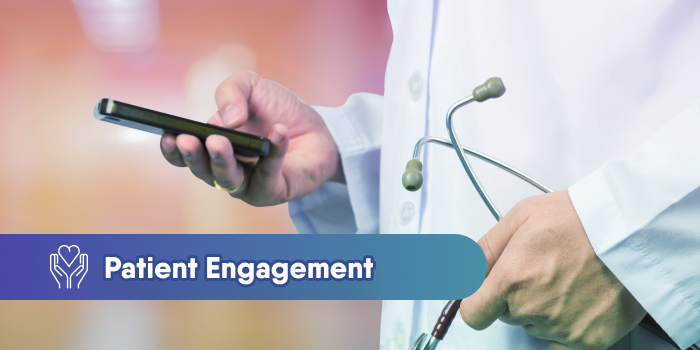Based on emerging technologies, healthcare futurists predict that by 2040, healthcare consumers will be at the center of the clinical system model. In the traditional setting, patients interact with their physicians or the healthcare system when they are sick or need medical treatment. With COVID-19 limiting direct contact, more consumers demand a technology-based approach for clinical communication and collaboration.
A successful healthcare delivery process relies heavily on innovation, digitization, and collaboration as the world manages the pandemic. The future of healthcare focuses on digital technologies and transformation as prominent key trends to resolve health crises and generate future growth in medicine.
Patient communication is an essential part of physician competency and positive patient experience. Their perception of the quality healthcare that they receive highly depends on their healthcare providers. There’s abundant research data that supports the benefits of effective communication to healthcare outcomes.
At present, health information and communication technologies (ICT) focus on the critical trends to facilitate effective communication between healthcare providers and consumers, promote medical safety, tracking, reporting, and improve patient care quality.
Knowing that healthcare consumers prefer to use technology for communication and health services, emerging trends boost patient communication to achieve better outcomes and improve public health.
Expansion and stability of telemedicine
The telemedicine trend skyrocketed when the pandemic hit. In the United States alone, 71% of patients considered telemedicine during the early phase of the COVID-19 outbreak. As a leading subset of telehealth, its growth is likely to continue even after the pandemic.
From simple phone calls, the role of telemedicine at present transformed into a more convenient medical practice via real-time interactive consultation. Patients opt for telemedicine because of:
- Quick and easy healthcare access without having to leave their homes
- No more waiting in line for appointments
- Less contact between physicians and patients
- Lower costs
- Improved quality patient care
Patients can book their checkups and access their medical records in a digital database with just a few clicks away. This trend is a more comfortable approach, especially for patients who want a seamless digital healthcare experience. Additionally, telemedicine allows mobile collaboration between doctors and patients from multiple locations at any given time.
Telemedicine provides an omnichannel approach for doctors to reach out to their patients in the latter’s preferred form. Channels such as text messaging, emails, calendar notifications, and mobile applications demonstrate physicians’ active involvement in their patient’s medical journeys even outside healthcare institutions.
Primarily, the telemedicine trend improves communication between healthcare providers and consumers, enabling more efficient and effective healthcare service delivery. As its scope expands, the benefits of telemedicine will continue to be more evident in a wide range of care needs.
Introduction of the Internet of Medical Things (IoMT)
The Internet of Things (IoT) exhibits the modern process of interconnection between technologies. It shows users the ability of technologies to transfer data over a network without the help of human-to-computer interaction.
Many industries are now adopting IoT to operate more efficiently, including the healthcare setting. In 2020, 30% of IoT technology market shares came from healthcare IoT devices.
As more medical devices and mobile apps emerge to play a critical role in tracking and preventing illnesses, the IoT development — with the stimulation of telehealth and telemedicine — transforms into the form of the Internet of Medical Things (IoMT).
The IoMT introduces various wearable technologies, tracking and monitoring devices, and integrated applications for medical needs. With the application of artificial intelligence (AI) and machine-learning technologies, IoMT provides an enhanced version of traditional medical devices, such as connected inhalers, heart-rate monitoring, glucose monitoring, etc. For instance, IoT-connected inhalers help patients monitor the frequency of their asthma attacks and collect data from external variables for healthcare professionals to understand what triggers an attack.
The most common application of IoMT devices is remote patient monitoring. Wearable technology like biosensors and smartwatches allows healthcare providers to monitor patient’s conditions remotely and gather data such as body temperature, pulse and breathing rate, and other vital signs.
As the IoMT device automatically collects health metrics, it forwards the data to a software system that healthcare providers and patients can access. Algorithms analyze the collected data to come up with proper treatment or notify emergency alerts.
Effective and consistent patient communication using various IoMT technologies enhances patient care satisfaction and builds a solid foundation for delivering remote healthcare services.
However, as healthcare technology continues to improve, portability, security, and accessibility are desired to ensure the privacy of the collected patients’ health data by IoT devices.
The rise of artificial intelligence (AI)
The trend of AI in the healthcare system is continuous innovation. Researchers have been testing AI and machine learning to a more complex medical scenario, wondering whether these innovations would live up to the hype and produce more advantageous outcomes for quality healthcare.
For years, healthcare providers have been integrating AI and machine learning for hospital administration and operation. AI with an information processing system similar to humans opens up many medical possibilities. Its analytics help healthcare professionals discover the right approach for early treatment. This process enhances the precision, speed, and efficiency of medical diagnoses.
Another form of AI technology and machine learning is the application of AI-powered chatbots. This technology revolutionizes the way physicians connect and collaborate with their patients to achieve better communication and engagement.
These AI-powered chatbots are integrated into the healthcare providers’ website or secured patient portal to offer the following services in the absence of a physician or customer support team:
- Real-time and interactive messages for patients who have questions regarding a specific medical illness
- Provide solutions for quick help with minor treatments
- Give immediate and alternative recommendations to patients in self-diagnosis, for example, screening for COVID-19 symptoms
- Assists physicians in early disease detection of patients
- Book patients’ appointments and notify them about their schedule via text message or email
- Authorize medical bill payments
- Helps in medication prescription or refill
AI chatbots provide real-time communication and task management to help improve patient engagement and reduce medical staff workloads. This technology allows healthcare providers to upgrade their digital infrastructure and create flexible and transparent solutions for patients.
The AI innovative trend’s potential to synergize with other healthcare technologies presents plenty of digital possibilities to produce more accurate diagnoses and advanced treatments. It will continue to rise, evolve, and become more integrated with clinical care in the coming years.
Need for Big Data Management
Integrating AI and machine learning technology into medical systems requires Big Data expansion as cloud servers continue to receive uploads of laboratory information systems, images, communication systems, and electronic medical and health records.
Effective patient communication is multidimensional. It streamlines clinical workflows within medical practices and helps exchange crucial and accurate information between healthcare providers and consumers, such as patient health data, medical history, insurance details, demographic data, etc.
Big data in the healthcare system refers to a large proportion of patient data sharing, more accessible patient care research, and transparency into medical details to increase patient data’s overall synthesis and analysis.
Some benefits of big data in the healthcare industry include:
- Providing healthcare practitioners access to comprehensive research studies for data-driven decisions
- Allowing medical professionals to stay on top of healthcare trends, techniques, and technologies with the use of more extensive and diverse health information
- Increase patient engagement and encourage better healthcare outcomes through collection and analysis of big data
- Access to data leading to positive results such as improvement in operations and patient care
With this innovation, identifying health risk factors is made easy and recommends the proper preventive treatment through data collection, assessment, and comparison from thousands of other patients’ data.
However, not all medical data is available for the public’s access because of privacy concerns. In terms of patient health information, electronic medical records (EMRs) and electronic health records (EHRs) are only accessible by attending physicians and their patients. Widespread adoption of EMRs and EHRs helps make healthcare more efficient, less costly, and determine the best practice.
In addition, a growing number of EHR software sellers integrate the use of digital voice assistants or virtual assistants into their system. Some of these AI-powered virtual assistants help manage patient appointments, record patient vitals into flowsheets, and automate EHR documentation, all while listening and understanding the context of a doctor-patient conversation. The collected data are being uploaded on healthcare-specific clouds to use as a reference for future medication and treatment.
The need for more extensive Big Data management speeds up data gathering and reporting through cloud implementations. It also allows patients to be more knowledgeable about their conditions and promotes active participation in shared decision-making with their physicians. However, healthcare providers need to adopt security measures designed to safeguard patient information from being exposed in a security breach.
Availability of blockchain
Security is a major issue in the healthcare industry, especially now that the big data trend is expanding and will continue to do so in the following years. The demand for blockchain healthcare applications increases to address such critical issues.
Blockchain’s ability to keep an incorruptible, decentralized, and transparent record of all patient information makes it innovative for security applications. In addition, this technology offers privacy features that conceal an individual’s identity by using complex and secure codes to protect their sensitive medical data. It also allows healthcare providers and consumers to share the same information in a safe and secured database.
To further explain the technology of blockchain, here’s a quick review of its features:
- A blockchain is a database application that stores encrypted blocks of data, then incorporates them all together to create a chronological single-source-of-truth for the data
- Blockchain distributes digital assets instead of copying or transferring them to form an unchangeable record
- Digital assets are decentralized, allowing complete real-time access and transparency of the records
The use of blockchain technology reduces the fear of healthcare providers and consumers regarding the exposure of private health information. Its ability to heavily secure health data improves overall patient satisfaction and builds concrete trust for healthcare providers.
Through the COVID-19 pandemic, health is of the utmost importance. Patients interact with the healthcare system in varying degrees and will continue to reach out as long as they need patient care. The same thing applies to healthcare industry innovations. Technology is enhancing the entire healthcare experience of providers and consumers and will continue to do so through digital transformation.
The positive impact of healthcare innovations is clear. Healthcare providers adopting digital transition receive the benefits provided by healthcare technologies, trends, and integrated systems.
Innovations help improve the quality and efficiency of healthcare, develop new medical approaches, offer various advanced treatment options, provide more extensive and secured data access, and even implement alternative clinical strategies.
The pandemic caused a massive disruption in the healthcare industry, pushing the sector to ramp up its digital presence by investing more in new technologies. Healthcare providers who adopt these innovative trends in patient communication will likely gain more loyal patients and drive better patient satisfaction while potentially increasing their revenue.


.png)
.png)
 6 Min Read
6 Min Read
 0
Comments
0
Comments


